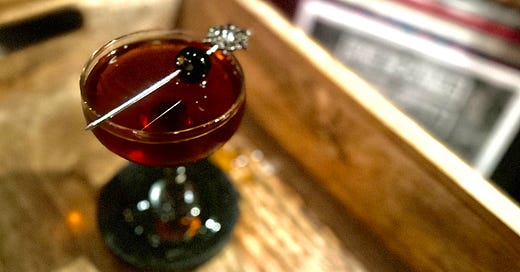The Bobby Burns and the Manhattan Plus Family of Drinks
When you want a Manhattan...and a little bit more.
If you have even a passing familiarity with classic cocktails, you have almost certainly made a Manhattan, or perhaps even quite a few Manhattans.
The Manhattan is one of the most important, most elemental cocktails. A well-made Manhattan is easy to make, with just three common ingredients in an easy-to-remember ratio: Two parts whiskey to one part sweet vermouth — about three ounces, before dilution — with a couple dashes of bitters to tie it all together. A Manhattan is boozy, spicy-sweet, slyly bitter, warm, and inviting. It’s especially welcome on dark, cold, winter nights, but it works in any weather, in any context. A well-made Manhattan is a treat on any occasion.
And yet. Sometimes what you want is a cocktail that is Manhattan-esque…but not quite a Manhattan. You want something that does the same work, but isn’t exactly the same you’ve had so many times before.
I sometimes think of the Manhattan as playing a similar role in the world of cocktails that the original Die Hard plays in the world of action movies: an endlessly rewatchable, simple-but-flawless classic that has been riffed on for decades, to better and worse effect. If you’re an action movie fan of a certain vintage, you’ve probably seen Die Hard countless times, and rewatching it is always enjoyable. But every now and then, to change things up, you find yourself watching Speed, which is really just Die Hard…but on a bus. Speed is derivative in some ways, but still pretty good on its own, and enjoyable for similar reasons. Speed is Die Hard Plus.
Fortunately, the cocktail world has delivered us a number of drinks that works the same way, but for the Manhattan. They are Manhattan riffs, but I like to think of them as their own broad subcategory: the Manhattan Plus.
A Manhattan Plus is recognizably a Manhattan in some way, but with an extra ingredient, or perhaps a few. These are Manhattan riffs that go beyond mere whiskey swaps, adding something new and different to the formula: an additional flavor, an unusual ingredient or two, an extra modifier or a less-common modifier in place of a traditional ingredient. Many prime examples consist of four or five ingredients, although some have just three, and some occasionally stretch into five or six-ingredient territory. Many, though not all, of these drinks come in at just over three ounces before dilution: What defines them is that they are expansions rather than mere revisions.
A Manhattan Plus is a Manhattan — and a little bit more.
Over the past two years and change, we’ve looked at a number of drinks that meet the criteria for inclusion in the Manhattan Plus. Today we’re going to review some of those drinks, then look at multiple ways to one of the simplest drinks in the Manhattan Plus toolkit: the Bobby Burns, a simple, delicious, three(ish)-ingredient classic that every Manhattan fan should try in some form or another.
Start With the Structure of a Manhattan
I write a lot about cocktail structure and ingredient ratios in this newsletter for a reason: Understanding basic cocktail structures is the fastest path toward a general understanding of cocktail composition and construction. It’s the easiest way for home bartenders to learn to either create their own drinks or make effective swaps when ingredients are limited.



